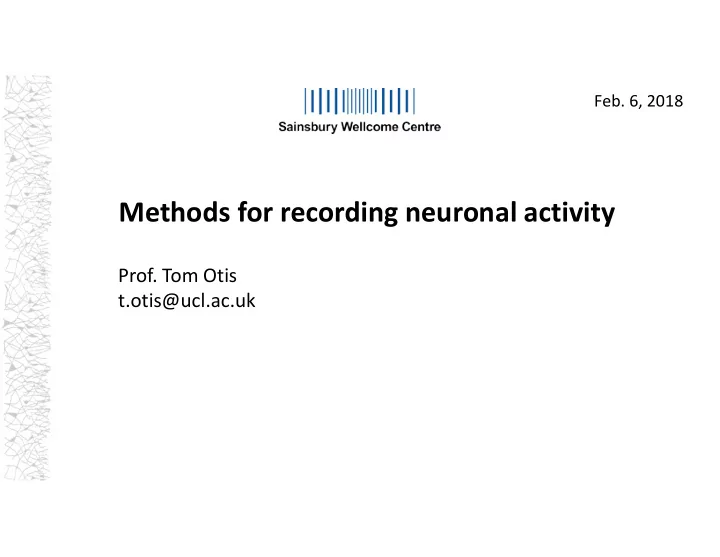

Feb. 6, 2018 Methods for recording neuronal activity Prof. Tom Otis t.otis@ucl.ac.uk
From ‘animal electricity’… to how nerves work Galvani, 1780 Galvani, 1791
First electrical recordings of a nerve impulse frog sciatic nerve Herbert Gasser Joseph Erlanger American J. Physiol., 1922
First recordings of light-evoked activity in optic nerve Conger eel optic nerve Lord Edgar Douglas Adrian J. Physiology, 1927 "I had arranged electrodes on the optic nerve of a toad in connection with some experiments on the retina. The room was nearly dark and I was puzzled to hear repeated noises in the loudspeaker attached to the amplifier, noises indicating that a great deal of impulse activity was going on. It was not until I compared the noises with my own movements around the room that I realised I was in the field of vision of the toad's eye and that it was signalling what I was doing."
Mechanism of the nerve impulse Squid giant axon Alan Hodgkin Andrew Huxley Nature, 1939
Hodgkin Huxley model of the action potential http://nerve.bsd.uchicago.edu/ Fig.1 Fig.4 Hodgkin, Huxley, and Katz, J. Physiol., 1952
Intracellular measurements with a microelectrode Ag/AgCl wires are standard in physiological contexts due to their excellent bidirectional ionic mobility, stability instrument The Axon Guide, 3 rd Ed.
Microelectrode methods for intracellular recording ‘sharp’ microelectrode 3 M KCl, 3 M K Acetate 80-100 M 10 microns whole-cell patch pipette physiological internal e.g. 130 K MeSO 4 2-5 M 10 microns
Patch clamping Bert Sakmann Erwin Neher from Purves et al, Neuroscience 5 th Ed. 2012 https://youtu.be/M3xN4Ihmt7U
Microelectrode methods for intracellular recording Rat dentate gyrus granule cells Staley et al., J. Neurophysiol . 67 : 1346, 1992
Metal electrodes lower resistance tungsten iridium platinum/iridium glass-coated polyimide-coated higher resistance
Recording from populations of single neurons: tetrodes microwire tetrode Thomas Recording tetrode see Recce & O’Keefe, 1989 Buzsáki , Nat. Neurosci. 2004
Recording from populations of single neurons: tetrodes Halverson et al., J. Neurosci. 35:7182-32, 2015 O’Keefe & Recce, 1993
Utah array to Neuropixel probes R. Normann, Uni. Utah see also https://www.youtube.com/watch?v=ItI6PqSTdHQ & Kelly et al, J. Neurosci. 27 :261-74, 2007 Jun et al., Nature 2017
2009
Small molecule Ca ++ dyes: A range of affinities and kinetics Table 1. SM Dye Dissociation Constants for Calcium . Small Molecule dye K D (μM) Reference Fura-2 0.16 (Kao and Tsien 1988) Magnesium green 7 (Zhao et al. 1996) (Konishi and Watanabe Fura dextran (10,000 MW) 0.52 1995) Calcium green dextran (3,000 MW) 0.54 (Haugland 1996) Fluo-4 dextran (10,000 MW) 3.1 Kreitzer et al., Neuron 27 :25 (2000)
Dye imaging from a presynaptic terminal Kreitzer et al., Neuron 27 :25 (2000)
Ca ++ dyes in vivo ‘Bulk loading’ Garaschuk & Konnerth, Nature Protocols 1 :380-6, 2006
Optogenetic sensors and actuators Miesenböck, Science, 2009
Conditional genetics and lab mice Breeding strategy cerebellum Viral strategy Cre-dependent virus from Knopfel, Nat. Rev. Neurosci. 2012
A revolution in biotechnology caused by a protein from a jellyfish Green fluorescent protein Aequorea victoria 2008 Nobel prize in Chemistry: Shimomura, Chalfie, & Tsien
Fundamentals of fluorescence From Ch.11, Fundamentals of Light Microscopy and Electronic Imaging , 2 nd Ed., Murphy & Davidson
Multicolored fluorescent proteins From Murphy and Davidson, Ch 11
Circularly-permuted GFP and ‘CAMgaroo’ An apt nickname for this construct is ‘‘camgaroo1,’’ because it is yellowish, carries a smaller companion (calmodulin) inserted in its ‘‘pouch,’’ can bounce high in signal, and may spawn improved progeny. Baird et al., PNAS 96 :11241-46, 1999
The GCaMP family of calcium sensors GCaMP1 described in 2001: Nakai et al.,, Nat. Biotech. 19:137 GCaMP6: Chen et al., 2013 Nature , 499:295 See also B-GECO and R-GECO crystal structure of GCaMP2: Akerboom et al., JBC 284:6455, 2009
Imaging while the mouse navigates a virtual reality maze Dombeck et al., Nature Neuroscience 13:1433
CAMPARI, a conditional integrator of neural activity Fusque et al. Science , 347 :755-60, 2015
CAMPARI performance in vivo Fusque et al. Science , 2015
Optical sensors of voltage
A non-genetic voltage sensor that relies on FRET-based quenching Bradley et al., J. Neurosci. , 2009
Two photon compatibility, high SNR = 940 nm 3 m M DPA Fink et al., PLOS One, 2012
Laser spot photometry from different regions of the same neuron Bradley et al., J. Neurosci. , 2009
Small molecule voltage dyes JPW-3028 Acker & Loew, Ch. 11 Chemical Neurobiology. Meth. Mol. Biol., 2013, doi.org/10.1007/978-1-62703-345-9_11
A comparison of genetic and non-genetic optical voltage sensors from Supplementary Material Kralj et al., Nat. Methods , 9 : 90-5, 2011; see also Table 1 in Xu et al, Curr. Op. Chem. Biol., 2017
Genetically encoded voltage indicator (GEVI) strategies FRET-based GEVI Single FP- or cpFP-based GEVI Opsin-based GEVI Knopfel, Nat. Rev. Neurosci ., 2012
Circularly-permuted FP-based GEVIs Xu et al. Curr. Opin. Chem. Biol. 39 : 1-10 (2017)
Opsin-based GEVIs also a FRET-based GEVI! Xu et al. Curr. Opin. Chem. Biol. 39 : 1-10 (2017)
Archaerodopsin , an opsin-based GEVI C QY for eGFP is ~0.65 and for mNEON is ~0.8 Kralj et al., Nat. Methods , 9 : 90-5, 2011
A FRET-based GEVI, Ace2N-mNeon Opsin (McQ or Ace) Gong et al., Nat. Comm. 5 : 3674, 2014; Gong et al., Science , 350 : 1361, 2015
The current state of the art- the cpGFP-based GEVI ASAP1/2f Lee & Bezanilla, Biophys. J. 113 :2178-81, 2017
Why in vivo optical voltage measurements are challenging & GEVIs are not quite ready yet for recording single trial APs… • Sensors have just become fast enough • Sensors are not yet bright enough • The brevity of AP signals makes measurement tough (photon counts, instrumentation, etc.) • Broad optical spectra (see FRET-based GEVIs) present challenges • Sensors rely on charges in the membrane (=capacitive load)
Discussion: which approach best suits the experiment? Cover of the 1963 Nobel Programme
Ca ++ dye, ratiometric emission Cooley et al., Ch. 10 Chemical Neurobiology. Meth. Mol. Biol., 2013, doi.org/10.1007/978-1-62703-345-9_11
Ca ++ dye, ratiometric excitation Cooley et al., Ch. 10 Chemical Neurobiology. Meth. Mol. Biol., 2013, doi.org/10.1007/978-1-62703-345-9_11
Recommend
More recommend